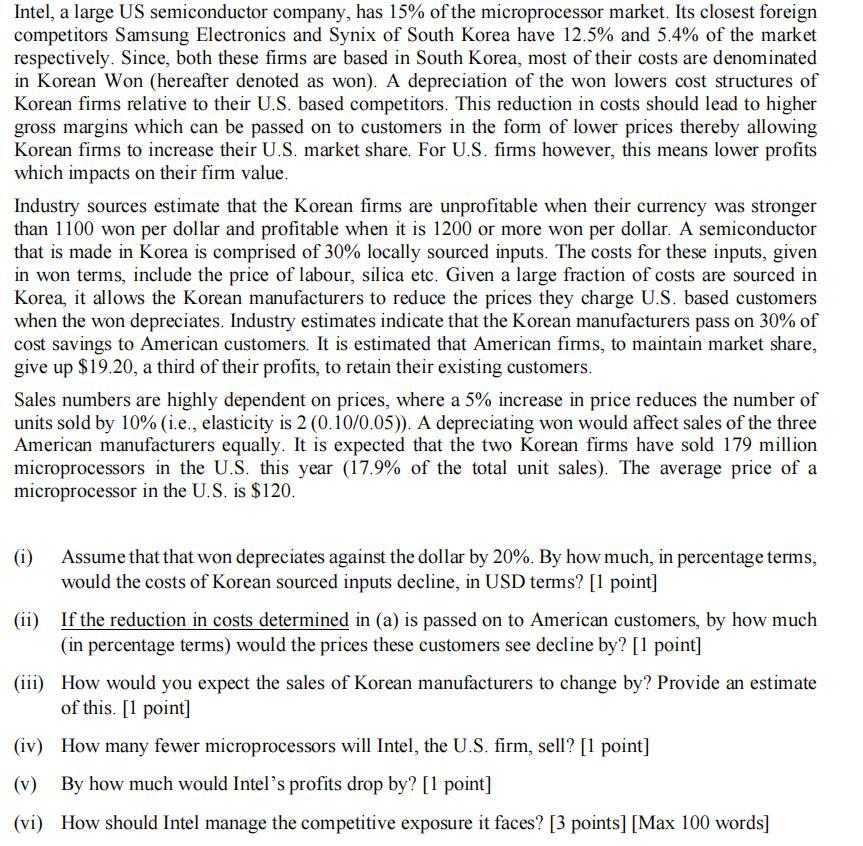
Intel, a large US semiconductor company, has 15% of the microprocessor market. Its closest foreign competitors Samsung Electronics and Synix of South Korea have 12.5% and 5.4% of the market respectively. Since, both these firms are based in South Korea, most of their costs are denominated in Korean Won (hereafter denoted as won). A depreciation of the won lowers cost structures of Korean firms relative to their U.S. based competitors. This reduction in costs should lead to higher gross margins which can be passed on to customers in the form of lower prices thereby allowing Korean firms to increase their U.S. market share. For U.S. firms however, this means lower profits which impacts on their firm value. Industry sources estimate that the Korean firms are unprofitable when their currency was stronger than 1100 won per dollar and profitable when it is 1200 or more won per dollar. A semiconductor that is made in Korea is comprised of 30% locally sourced inputs. The costs for these inputs, given in won terms, include the price of labour, silica etc. Given a large fraction of costs are sourced in Korea, it allows the Korean manufacturers to reduce the prices they charge U.S. based customers when the won depreciates. Industry estimates indicate that the Korean manufacturers pass on 30% of cost savings to American customers. It is estimated that American firms, to maintain market share, give up $19.20, a third of their profits, to retain their existing customers. Sales numbers are highly dependent on prices, where a 5% increase in price reduces the number of units sold by 10% (i.e., elasticity is 2 (0.10/0.05)). A depreciating won would affect sales of the three American manufacturers equally. It is expected that the two Korean firms have sold 179 million microprocessors in the U.S. this year (17.9% of the total unit sales). The average price of a microprocessor in the U.S. is $120. Assume that that won depreciates against the dollar by 20%. By how much, in percentage terms, would the costs of Korean sourced inputs decline, in USD terms? [1 point] (ii) If the reduction in costs determined in (a) is passed on to American customers, by how much (in percentage terms) would the prices these customers see decline by? [1 point] (iii) How would you expect the sales of Korean manufacturers to change by? Provide an estimate of this. [1 point] (iv) How many fewer microprocessors will Intel, the U.S. firm, sell? [1 point] (v) By how much would Intel's profits drop by? [1 point] (vi) How should Intel manage the competitive exposure it faces? [3 points] [Max 100 words] Intel, a large US semiconductor company, has 15% of the microprocessor market. Its closest foreign competitors Samsung Electronics and Synix of South Korea have 12.5% and 5.4% of the market respectively. Since, both these firms are based in South Korea, most of their costs are denominated in Korean Won (hereafter denoted as won). A depreciation of the won lowers cost structures of Korean firms relative to their U.S. based competitors. This reduction in costs should lead to higher gross margins which can be passed on to customers in the form of lower prices thereby allowing Korean firms to increase their U.S. market share. For U.S. firms however, this means lower profits which impacts on their firm value. Industry sources estimate that the Korean firms are unprofitable when their currency was stronger than 1100 won per dollar and profitable when it is 1200 or more won per dollar. A semiconductor that is made in Korea is comprised of 30% locally sourced inputs. The costs for these inputs, given in won terms, include the price of labour, silica etc. Given a large fraction of costs are sourced in Korea, it allows the Korean manufacturers to reduce the prices they charge U.S. based customers when the won depreciates. Industry estimates indicate that the Korean manufacturers pass on 30% of cost savings to American customers. It is estimated that American firms, to maintain market share, give up $19.20, a third of their profits, to retain their existing customers. Sales numbers are highly dependent on prices, where a 5% increase in price reduces the number of units sold by 10% (i.e., elasticity is 2 (0.10/0.05)). A depreciating won would affect sales of the three American manufacturers equally. It is expected that the two Korean firms have sold 179 million microprocessors in the U.S. this year (17.9% of the total unit sales). The average price of a microprocessor in the U.S. is $120. Assume that that won depreciates against the dollar by 20%. By how much, in percentage terms, would the costs of Korean sourced inputs decline, in USD terms? [1 point] (ii) If the reduction in costs determined in (a) is passed on to American customers, by how much (in percentage terms) would the prices these customers see decline by? [1 point] (iii) How would you expect the sales of Korean manufacturers to change by? Provide an estimate of this. [1 point] (iv) How many fewer microprocessors will Intel, the U.S. firm, sell? [1 point] (v) By how much would Intel's profits drop by? [1 point] (vi) How should Intel manage the competitive exposure it faces? [3 points] [Max 100 words]







